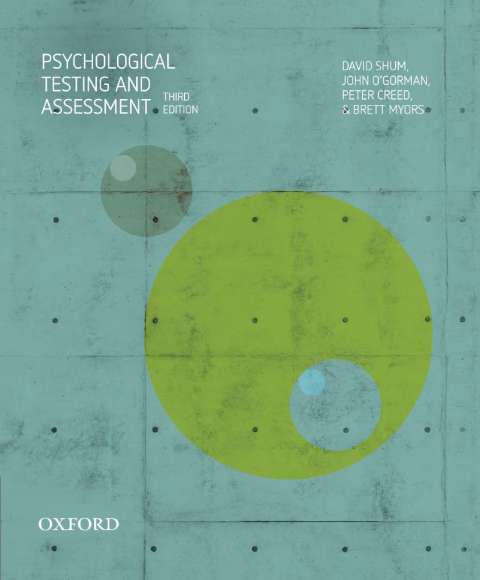Description
Efnisyfirlit
- Cover
- Halftitle
- Title
- Copyright
- Content
- Figures
- Tables
- Preface
- Acknowledgments
- PART 1 The Context of Psychological Testing and Assessment
- Chapter 1: Psychological Tests: What Are They and Why Do We Need Them?
- Introduction
- A brief history of psychological testing
- Psychological tests: why do we need them?
- Psychological tests: definitions, advantages and limitations
- Chapter 2: Psychological Testing and Assessment: Processes, Best Practice and Ethics
- Introduction
- Psychological testing versus psychological assessment
- Areas of application
- Types of psychological tests
- Processes and best practices in psychological testing
- Ethics
- Accommodating the differently abled
- Cultural differences, testing and assessment
- PART 2 Methodological and Technical Principles of Psychological Testing
- Chapter 3: Test Scores and Norms
- Introduction
- Interpreting test scores
- Transforming scores for norm referencing
- Standard scores and transformed scores based on them
- Percentiles and transformed scores based on them
- Relationships among the transformed scores
- Other methods of scoring
- Norms
- Chapter 4: Reliability
- Introduction
- The meaning of reliability
- The domain-sampling model
- Calculating reliability coefficients
- Extending the domain-sampling model
- Some special issues
- Chapter 5: Validity
- Introduction
- The meaning of validity
- Content validity
- Predictive validity
- Construct validity
- Factor analysis
- Chapter 6: Test Construction
- Introduction
- The rational-empirical approach
- Specification of the attribute
- Literature search
- Choice of a measurement model
- Item writing and editing
- Item analysis and selection
- Assessing reliability and validity
- Norming the test
- Publication
- PART 3 Substantive Testing and Assessment Areas
- Chapter 7: Intelligence
- Introduction
- The concept of intelligence
- Binet’s revolution
- Spearman and ‘g’
- Terman and the Stanford-Binet Intelligence Scale
- Wechsler scales
- Thurstone and multiple mental abilities
- Guilford: A different structure of intelligence
- Vernon’s hierarchical view of intelligence
- Cattell’s two-factor theory of intelligence
- Cattell, Horn and Carroll extend the ‘Gf-Gc’ model of intelligence
- The Cattell-Horn-Carroll (CHC) model of intelligence
- The CHC model and modern tests of intelligence
- A developmental conception of intelligence
- An information-processing view of intelligence
- Gardner and multiple intelligences
- Sternberg’s triarchic theory of intelligence
- So, ‘what is intelligence?’
- Aptitude versus achievement tests
- Group (rather than individual) testing
- Group differences in intelligence
- Chapter 8: Personality
- Introduction
- The psychoanalytic approach
- The interpersonal approach
- The personological approach
- The multivariate (trait) approach
- The empirical approach
- The social-cognitive approach
- Positive psychology
- Eclectic approaches
- PART 4 Areas of Professional Application
- Chapter 9: Clinical and Mental Health Testing and Assessment
- Introduction
- Clarifying the referral question
- Case history data
- Clinical interview
- Mental status examination
- Psychological tests
- Psychological report
- Chapter 10: Organisational Testing and Assessment
- Introduction
- Performance appraisal
- Theories of performance
- Personnel selection
- Selection as a social process
- Some tests used in selection
- Work attitudes
- Vocational interests
- Strong Interest Inventory
- Chapter 11: Neuropsychological Testing and Assessment
- Introduction
- What is clinical neuropsychology?
- A brief history of neuropsychological assessment
- What is neuropsychological assessment?
- Purposes and procedures of neuropsychological assessment
- Neuropsychological functions commonly assessed
- Chapter 12: Forensic Psychological Testing and Assessment
- Introduction
- Forensic psychology and forensic psychological testing and assessment
- Settings of forensic assessment
- Differences between forensic and therapeutic assessment
- Psychological tests and assessment techniques commonly used in forensic assessment
- Limitations of forensic assessment
- Chapter 13: Educational Testing and Assessment
- Introduction
- Group-administered achievement tests
- Naplan
- Individually administered achievement tests
- Teacher-constructed tests
- Aptitude tests
- Behaviour rating scales
- PART 5 Prospects and Issues
- Chapter 14: The Future of Testing and Assessment
- Introduction
- Construct development
- Technical and methodological developments
- Contextual changes
- Answers to Exercises
- Technical Appendix
- Glossary
- References
- Index







Reviews
There are no reviews yet.